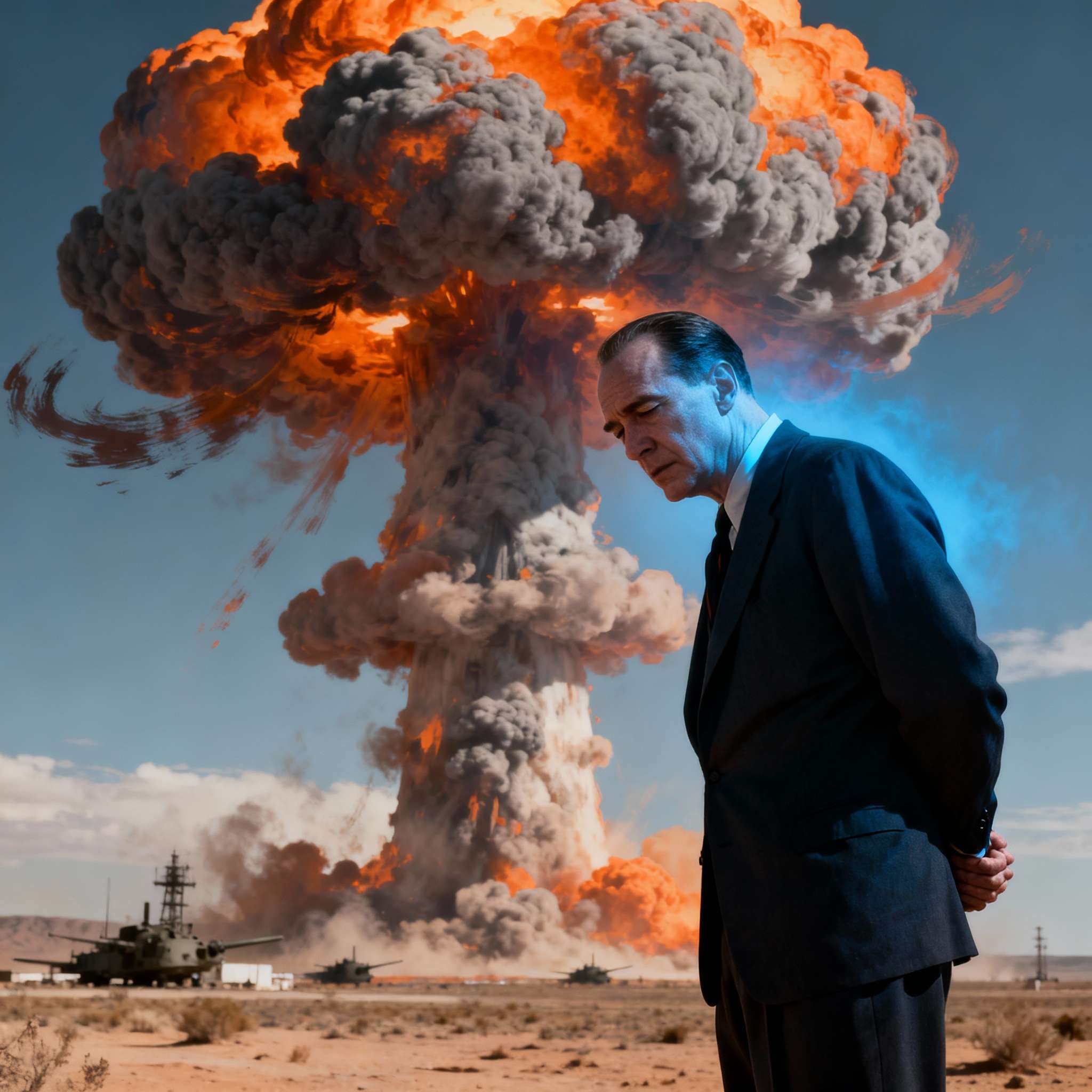In the summer of 1945, a scientist stood at the epicentre of a new era, one where the very essence of humanity and destruction was fused into a single weapon. J. Robert Oppenheimer, the physicist behind the atomic bomb, watched the world change forever with the success of the Trinity Test. Yet, as the mushroom cloud rose above the New Mexico desert, the shadow of his creation loomed larger than ever. “Now I am become Death, the destroyer of worlds,” Oppenheimer famously quoted from the Bhagavad Gita, an acknowledgment not just of his scientific triumph but of the haunting moral weight of the bomb’s potential. His story of scientific brilliance, ethical reckoning, and geopolitical intrigue offers a powerful lens through which we can examine the relationship between science, politics, and morality, issues that are just as relevant today.
From Cambridge to the quantum revolution
Oppenheimer’s journey into the world of quantum physics was marked by both brilliance and inner turmoil. In 1926, at the age of 22, he was studying experimental quantum physics under Patrick Blackett at the University of Cambridge. His intellectual curiosity was matched only by his emotional struggles, which included profound anxiety and homesickness. This period was pivotal not only in shaping his scientific trajectory but also his personal life, one that would later become embroiled in moral and political conflict.
While at Cambridge, Oppenheimer had a falling-out with Blackett, symbolised by a poisoned apple, which he later retrieved. This seemingly trivial incident hints at Oppenheimer’s tendency to clash with authority, a trait that would follow him throughout his career. He soon sought advice from the great Niels Bohr, who suggested Oppenheimer study theoretical physics in Göttingen, Germany. This move marked the beginning of a new chapter in his scientific journey, one where Oppenheimer would cement his reputation as a brilliant, albeit often controversial, physicist.
By the late 1930s, Oppenheimer had completed his PhD and was teaching at the University of California, Berkeley. It was here that he would meet the physicists who would become his closest collaborators, figures like Isidor Isaac Rabi, Hans Bethe, and Edward Teller. These collaborations were crucial in the development of quantum mechanics and set the stage for the groundbreaking discoveries that would later become the foundation for the atomic bomb. In fact, it was when Germany successfully split the atom in 1938 that Oppenheimer realised the potential for nuclear fission to be weaponised.
The Manhattan project
When World War II intensified, the U.S. government, fearing that Nazi Germany might develop a nuclear weapon first, launched the Manhattan Project. Oppenheimer was appointed as the scientific director of the Los Alamos Laboratory, where he would oversee the development of the atomic bomb. The stakes were high, and Oppenheimer was not just playing a scientific role but a deeply geopolitical one. He was tasked with developing a weapon that could potentially change the course of the war and ensure American superiority.
His scientific acumen and leadership were undeniable, and he quickly assembled a team of brilliant minds to tackle the problem of creating an atomic bomb. Alongside Rabi, Bethe, and Teller, Oppenheimer worked with luminaries like Enrico Fermi, Leo Szilard, and David L. Hill. However, despite their collective brilliance, the project was fraught with technical, moral, and emotional challenges.
One of the most significant hurdles came when Teller calculated that an atomic detonation might trigger a chain reaction that could destroy the entire world. After consulting with Albert Einstein, Oppenheimer’s team reassured themselves that the chances of such a catastrophic event were “near zero.” Yet, as the project proceeded, Oppenheimer’s growing unease mirrored the escalating moral dilemmas he faced as the destructive potential of his work became more apparent.
The bombing of Hiroshima and Nagasaki
In 1945, the Trinity Test marked the first successful detonation of an atomic bomb. The world had entered a new epoch, one where the very future of humanity was now at risk. Following Germany’s surrender, Japan’s refusal to capitulate led to the use of atomic bombs on Hiroshima and Nagasaki. President Harry S. Truman ordered the bombings, believing they would expedite Japan’s surrender and save lives by avoiding a prolonged war.
Yet, for Oppenheimer and many of the scientists involved, the successful test and subsequent bombings were a source of deep moral conflict. Despite their role in developing the weapon, Oppenheimer was haunted by the sheer devastation the bomb wrought on civilian populations. In a meeting with President Truman, Oppenheimer expressed his remorse, only to be coldly rebuffed. Truman, who had supported the bomb’s use, dismissed Oppenheimer’s concerns, and the scientist was left to grapple with the enormity of what he had helped create.
Despite the military success of the bombings, the moral and political fallout was immediate. Oppenheimer, now a national hero, became increasingly vocal in his concerns about the future of nuclear weapons. He opposed further development of the hydrogen bomb, which would prove to be even more destructive. This opposition, coupled with his willingness to engage in negotiations with the Soviet Union after they detonated their own atomic bomb in 1949, set the stage for a political conflict that would ultimately tarnish his career.
Oppenheimer’s decline and the Cold War
In the midst of the burgeoning Cold War, Oppenheimer’s political views clashed with those of many in the U.S. government. As an advisor to the Atomic Energy Commission (AEC), Oppenheimer found himself at odds with figures like Lewis Strauss, who held conservative views on nuclear policy. Strauss resented Oppenheimer’s opposition to the development of the hydrogen bomb and his advocacy for international cooperation in nuclear disarmament.
In 1954, Strauss orchestrated a public security hearing aimed at discrediting Oppenheimer and revoking his Q clearance. The hearings, conducted by the Personnel Security Board, were politically motivated and aimed at eliminating Oppenheimer’s influence on U.S. nuclear policy. The hearing became a circus, with Oppenheimer’s past political associations twisted against him. Even though his loyalty to the United States was never definitively questioned, his clearance was revoked, and his public reputation was severely damaged.
The aftermath of these hearings highlighted the precarious relationship between science and politics. Oppenheimer, once the face of American scientific achievement, was now the target of a political campaign designed to eliminate him as a potential threat to the establishment. The security hearings, in many ways, mirrored the McCarthy-era witch hunts, which sought to root out perceived communist sympathies from American society. Oppenheimer’s downfall serves as a cautionary tale about the dangers of political interference in scientific discourse.
The man who created the bomb and the man who regretted it
Despite the controversy that marred his later years, Oppenheimer’s scientific legacy endures. In 1963, President Lyndon B. Johnson presented Oppenheimer with the Enrico Fermi Award, an attempt to restore some measure of honour to his name. But by then, Oppenheimer had become a symbol of the complex interplay between science, ethics, and geopolitics.
Today, Oppenheimer’s story remains relevant as the world grapples with the consequences of scientific discovery. His life underscores the power of science to shape the future, for better or for worse. It raises important questions about the role of scientists in decision-making, especially when their work has the potential to alter the course of history. Should scientists be held accountable for the uses of their discoveries, even if they were initially intended for peaceful purposes? How do we navigate the ethical complexities of scientific progress, especially when it comes to technologies that could cause widespread harm?
In an age where emerging technologies such as artificial intelligence, biotechnology, and nuclear energy continue to push the boundaries of what is possible, Oppenheimer’s moral struggles offer crucial insights into the responsibilities of today’s researchers. As we face new challenges, ranging from climate change to global security, scientists, policymakers, and the public alike must ask: What role should science play in shaping the future, and who holds the power to guide it?
Are we prepared for the moral and geopolitical consequences of our discoveries? And perhaps more importantly, how can we ensure that science serves the greater good without becoming a tool of destruction?







